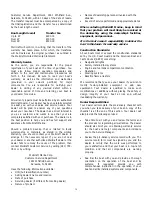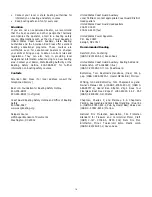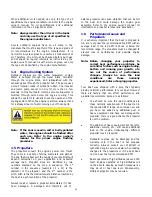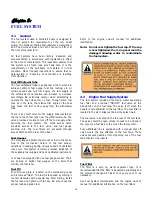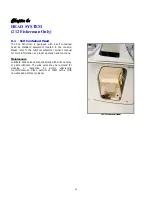
Chapter 2:
HELM CONTROL SYSTEMS
2.1
General
The helm controls consist of three systems: the engine
throttle and shift controls, the steering system, and the
trim tab control switches. These systems provide the
operator with the ability to control the direction and
attitude of the boat from the helm station.
Each manufacturer of the control components provides
an owner’s manual with it’s product. It is important that
you read the manuals and become familiar with the
proper care and operation of the control systems.
2.2
Engine Controls
The shift and throttle controls on your boat may vary
depending on the engine used. The following control
description is typical of most outboard remote controls.
Refer to the engine or control manuals for specific
information on the controls installed on your Wellcraft.
The engine throttle and shift control system consist of
three major components: the control handles, the
throttle cable and the shift cable. The cables are all the
push-pull type. Two cables are required for each engine.
One cable connects the remote throttle control to the
carburetor or fuel injectors and the other connects the
remote shift control to the engine shift rod linkage.
The helm on your Wellcraft is designed for a binnacle
style control with a single lever that operates as a gear
shift and a throttle. General operation will include a
position for neutral (straight up and down), a forward
position (the 1
st
detent forward of neutral), and a
reverse position (the 1
st
detent aft of neutral).
Advancing the control lever beyond the shift range
advances the throttle in forward or reverse. Each control
is equipped with a means of permitting the engine to be
operated at a higher than idle RPM while in neutral for
cold starting and warm-up purposes.
2.3
Neutral Safety Switch
Every control system has a neutral safety switch
incorporated onto it. This device prohibits the engine
from being started while the shift lever is in any position
other than the neutral position. If the engine will not
start, slight movement of the shift lever may be
necessary to locate the neutral position and disengage
the safety cutout switch. Control or cable adjustments
may be required to correct this condition should it
persist.
See your Wellcraft dealer for necessary control and cable
adjustments.
The neutral safety switches should be tested periodically
to ensure that they are operating properly. To test the
neutral safety switches, make sure the engine is tilted
down and move the shift lever to the forward position.
Make sure the throttle control lever is not
advanced past the idle position.
Turn the ignition
key to the start position just long enough to briefly
engage the starter for the engine.
Do not hold the key
in the start position long enough to start the
engine.
The starter should not engage the engine.
Repeat this test with the shift lever in reverse and the
engine throttle at idle. Again, the starter should not
engage. If the starter engages with the shift control in
any position other than the neutral position, then the
neutral safety switch is not functioning properly and you
should contact your dealer to have the neutral safety
switch repaired by a qualified marine mechanic before
using the boat. If the engine starts in gear during this
test, immediately move the control lever to the neutral
position and turn the engine off.
2.4
Engine Power Tilt and Trim
All outboard engines have a tilt and trim feature. Most
outboard engines have tilt/trim switches built into the
engine shift and throttle controls that allow the operator
to control the position of the outboards from the helm.
Moving the outboard closer to the boat transom is called
trimming “in” or “down”. Moving the outboards further
away from the boat transom is called trimming “out” or
“up”. In most cases, the boat will run best with the
outboards adjusted so the hull will run at a 3 to 5
degree angle to the water.
26
Summary of Contents for 180 Sportsman
Page 2: ...2...
Page 4: ...4...
Page 7: ...180 FISHERMAN SPECIFICATIONS 7...
Page 8: ...180 SPORTSMAN SPECIFICATIONS 8...
Page 9: ...202 FISHERMAN SPECIFICATIONS 9...
Page 10: ...212 FISHERMAN SPECIFICATIONS 10...
Page 18: ...18...
Page 39: ...SAFETY LABELS 2601 1124 39...
Page 40: ...180 FISHERMAN 180 SPORTSMAN CAPACITY LABELS 40...
Page 41: ...202 212 FISHERMAN CAPACITY LABELS 41...
Page 61: ...Appendix A SCHEMATICS 180 FISHERMAN INSTRUMENT PANEL 61...
Page 62: ...Appendix A SCHEMATICS 180 SPORTSMAN INSTRUMENT PANEL 62...
Page 63: ...Appendix A SCHEMATICS 202 212 FISHERMAN INSTRUMENT PANEL 63...
Page 68: ...Appendix A SCHEMATICS 180 FISHERMAN 180 SPORTSMAN TRAILER DRAWING 68...
Page 69: ...Appendix A SCHEMATICS 202 212 FISHERMAN TRAILER DRAWING 69...
Page 70: ...Appendix A SCHEMATICS 180 FISHERMAN OVERHEAD LAYOUT 70...
Page 71: ...Appendix A SCHEMATICS 180 SPORTSMAN OVERHEAD LAYOUT 71...
Page 72: ...Appendix A SCHEMATICS 202 FISHERMAN OVERHEAD LAYOUT 72...
Page 73: ...Appendix A SCHEMATICS 212 FISHERMAN OVERHEAD LAYOUT 73...
Page 77: ...MAINTENANCE LOG 77...
Page 78: ...MAINTENANCE LOG 78...
Page 80: ...Appendix D BOAT ACCIDENT REPORT 80...
Page 81: ...81...
Page 87: ...Appendix F TROUBLESHOOTING GUIDE 87...
Page 88: ...TROUBLESHOOTING GUIDE 88...
Page 89: ...TROUBLESHOOTING GUIDE 89...
Page 90: ...TROUBLESHOOTING GUIDE 90...
Page 91: ...TROUBLESHOOTING GUIDE 91...


